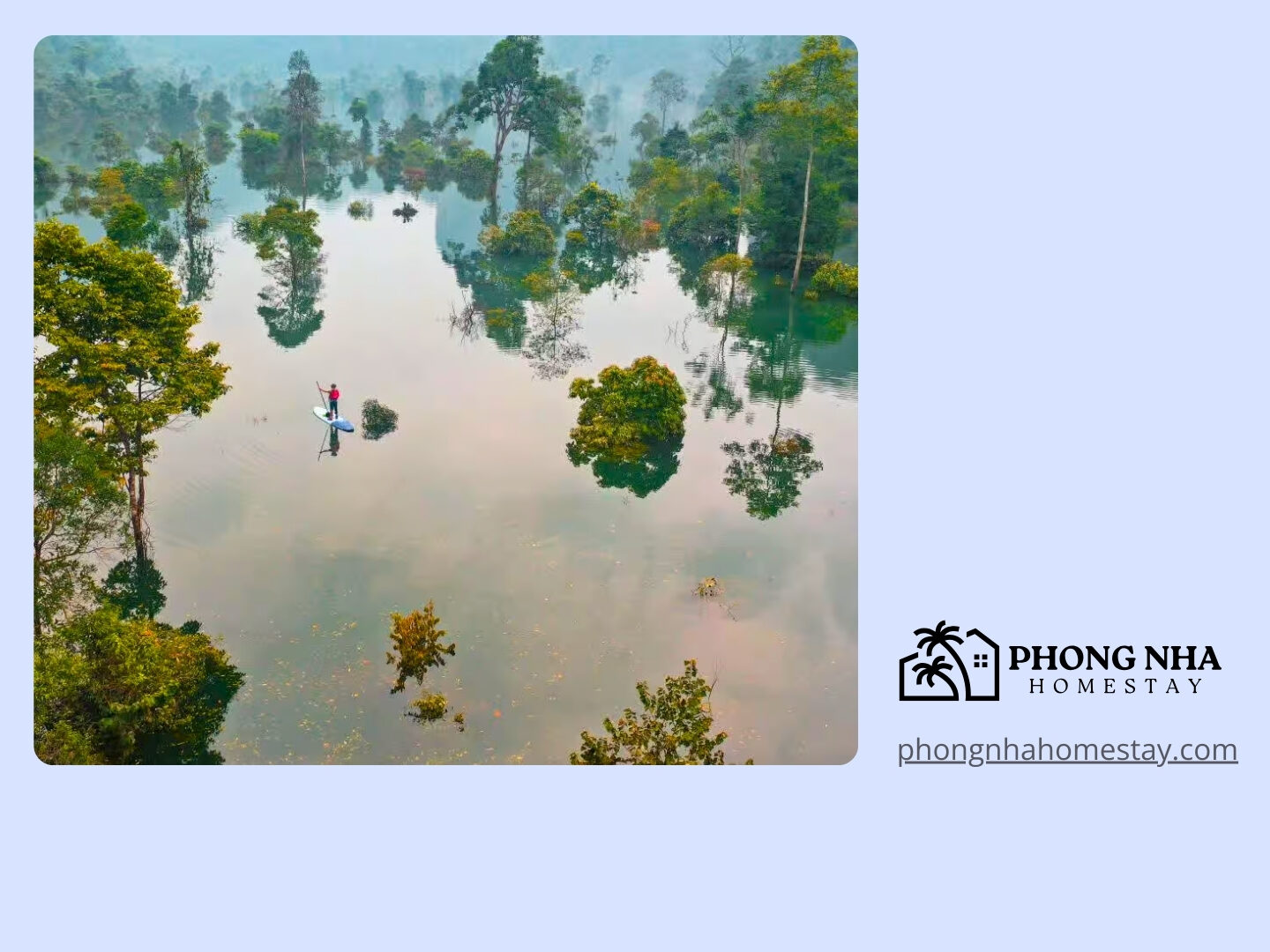When is the best time to visit Phong Nha? Are you wondering when to plan your dream trip to this breathtaking natural wonderland? Phong Nha, known for its lush landscapes and awe-inspiring caves like Son Doong and Paradise Cave, offers a unique experience year-round. But choosing the right season can make all the difference in your adventure.
The best time to visit Phong Nha is during the dry season from February to August. This period features sunny skies, comfortable temperatures, and low rainfall—perfect for exploring the stunning caves and engaging in outdoor activities. In contrast, the rainy season, from September to January, brings high humidity and occasional flooding, which can limit access to certain attractions. This article will guide you through the seasonal pros and cons, top activities, and expert travel tips for an unforgettable trip.
Whether you’re an adventure seeker or a nature lover, Phong Nha promises something extraordinary in every season. Dive into this guide on PhongNhaHomestay.com to discover the best time for your visit. From expert insights to practical tips, we’ll help you plan the perfect escape to this UNESCO World Heritage site!
Weather and Climate Overview
1.1 Dry Season (February to August)
The dry season in Phong Nha, lasting from February to August, offers the best conditions for outdoor exploration. During this time, the weather is marked by sunny skies, low rainfall, and moderate humidity. Temperatures range from 18°C to 34°C (64°F to 93°F), creating the perfect environment for trekking, kayaking, and exploring the caves.
Relatable tip: Pack light, breathable clothing, sunscreen, and a refillable water bottle for your adventures. The dry season is also the ideal time to explore the Son Doong Cave, the world’s largest cave, as water levels remain low.
Quick Facts:
- Temperature range: 18°C–34°C (64°F–93°F)
- Best for: Hiking, cave exploration, kayaking, and photography
Pro tip: Visit between February and April for cooler weather and fewer crowds.
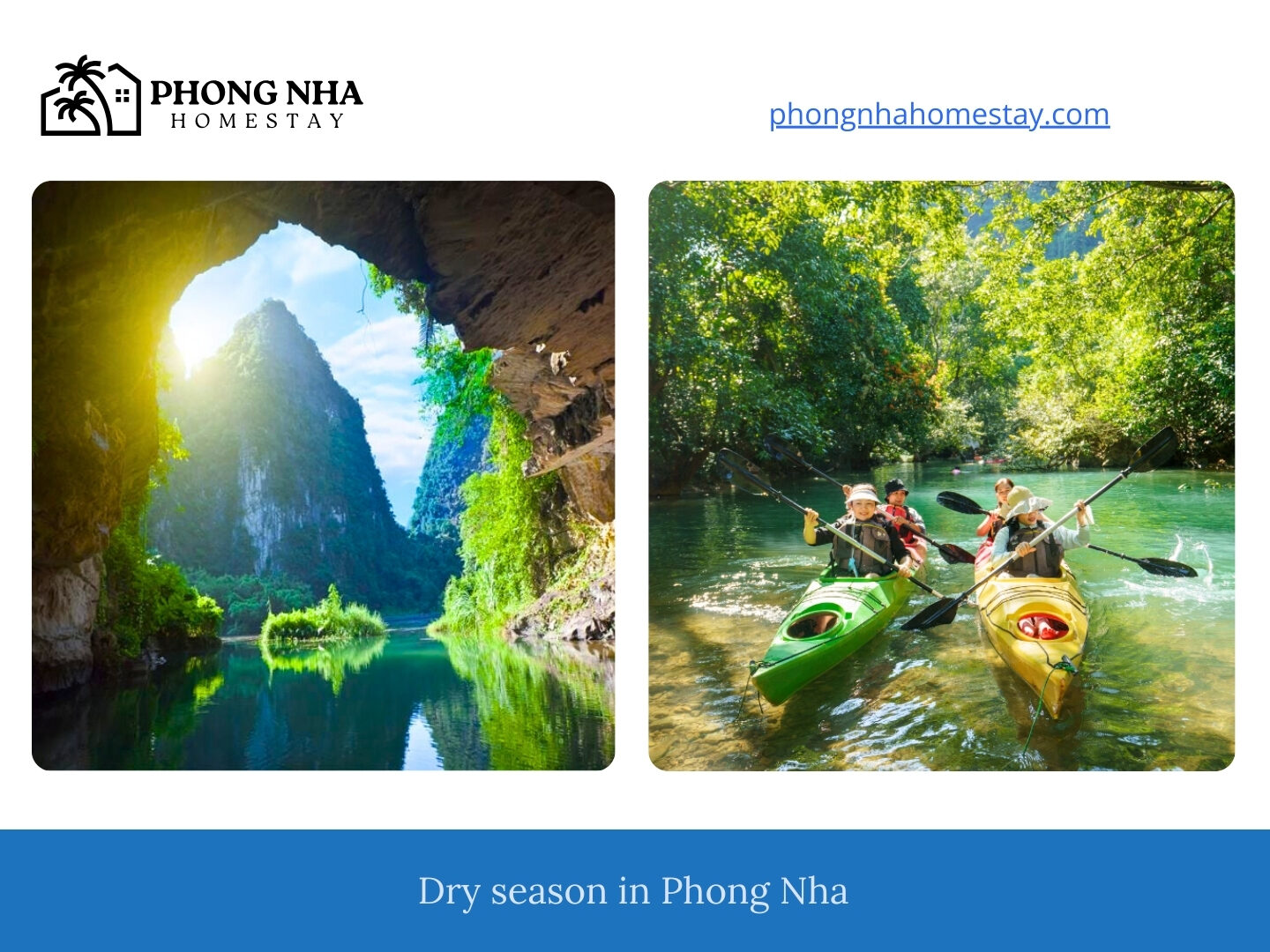
1.2 Rainy Season (September to January)
From September to January, Phong Nha experiences its rainy season, defined by frequent rain showers, high humidity, and occasional typhoons. Temperatures during this time range from 14°C to 24°C (57°F to 75°F), making it cooler but wetter. Rainfall is heaviest in October and November, sometimes leading to flooding that may restrict access to caves like Phong Nha Cave.
While the rainy season may pose challenges, it offers lush greenery, full rivers, and fewer tourists. You can still explore stunning attractions like Paradise Cave or enjoy relaxing at cozy local homestays.
Quick Facts:
- Temperature range: 14°C–24°C (57°F–75°F)
- Best for: Quiet travel, lush landscapes, and fewer crowds
Pro tip: Check weather conditions before planning and bring waterproof clothing and sturdy shoes.
1.3 Temperature Ranges (Seasonal Highs and Lows)
Phong Nha’s tropical monsoon climate features seasonal highs and lows that greatly influence travel plans:
- Summer (June to August): Highs of up to 41°C (105°F) make this the hottest period.
- Winter (December to February): Lows can drop to 6°C (42°F), offering a cooler but wetter experience.
The diversity in temperature ensures every visitor finds a season suitable for their preferences, from sunseekers to those who enjoy mild, cool weather.
Seasonal Breakdown:
- Peak summer months: Ideal for swimming and cave exploration.
- Winter months: Best for a serene, tranquil experience with fewer tourists.
1.4 Humidity and Rainfall Patterns
Phong Nha’s humidity remains consistently high, ranging from 70% to 90% throughout the year. Rainfall, however, varies drastically by season:
- Dry season: Rainfall averages between 50mm and 200mm per month, with fewer rainy days.
- Rainy season: Rainfall spikes to 400mm–500mm in October and November, making it essential to plan activities wisely.
Table: Rainfall Comparison
| Month | Average Rainfall (mm) | Rainy Days |
|---|---|---|
| Dry Season (Feb-Aug) | 50–200 | 5–12 |
| Rainy Season (Sep-Jan) | 400–500 | 20–25 |
Quick Tips:
- Always check the weather forecast before your trip.
- Plan cave visits like Dark Cave or Paradise Cave during the dry season to avoid closures.
Seasonal Travel Insights
2.1 Peak Tourist Season (February to April and June to August)
The peak tourist seasons in Phong Nha are from February to April and June to August. These months bring ideal weather with sunny skies and moderate temperatures, making them perfect for cave exploration, hiking, and kayaking. Attractions like Son Doong Cave and Paradise Cave see a surge in visitors during this time.
Expect vibrant energy and bustling local markets, but also higher accommodation rates. Plan ahead if you wish to visit during this time to secure tours and lodging.
Pro Tips:
- Book early: Reserve accommodations and cave tours 1-2 months in advance.
- Best experiences: Explore Paradise Cave for its grandeur and enjoy the lush landscapes of Phong Nha Botanic Garden.
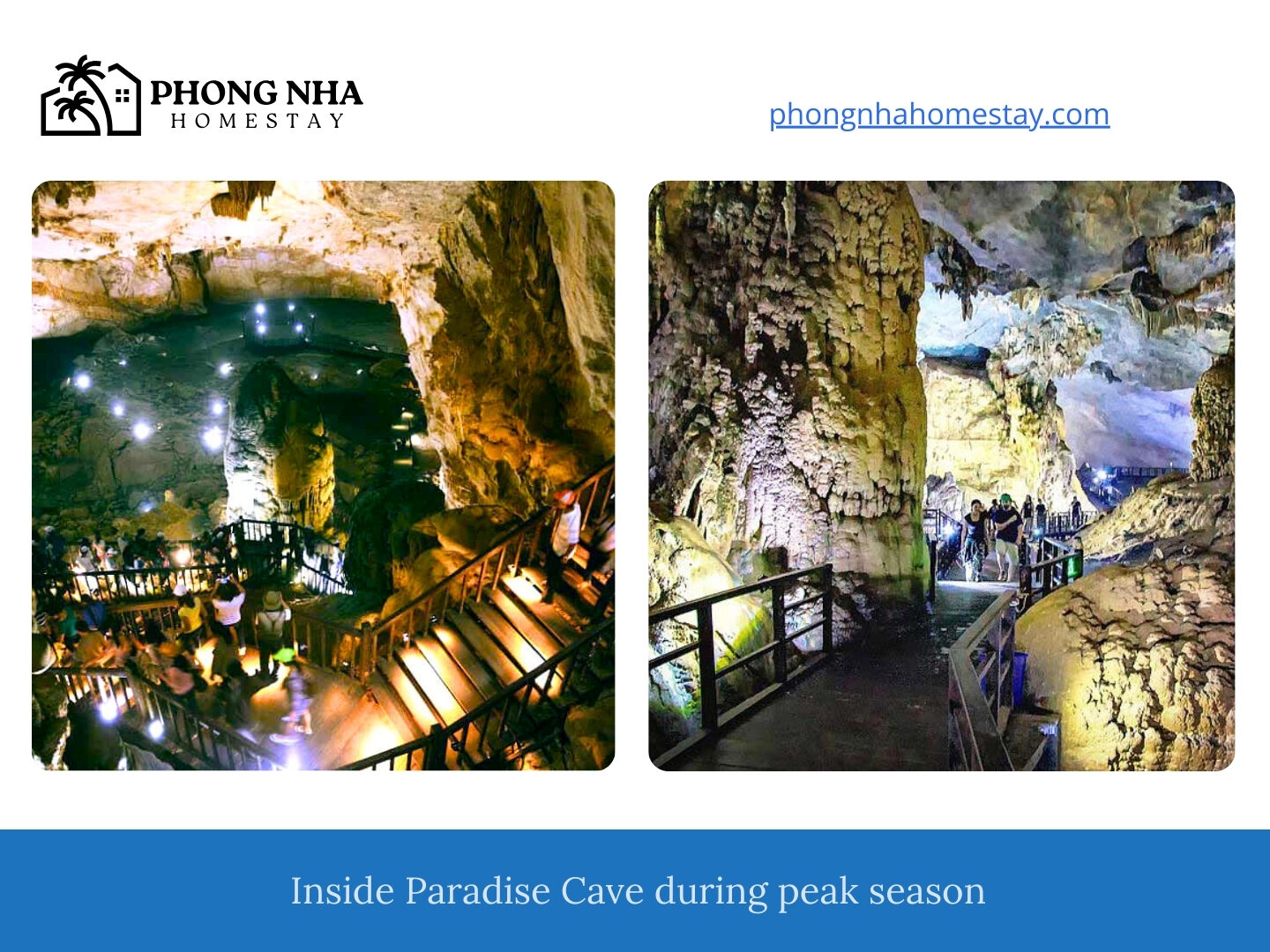
2.2 Off-Season Travel (September to January)
The off-season runs from September to January, coinciding with the rainy season. While the weather can be unpredictable with frequent rain and high humidity, this time offers a quieter, more serene experience. Many tourists skip visiting during this period, so you can enjoy a peaceful atmosphere.
Rainfall does affect cave accessibility, but you can still explore stunning spots like Tien Son Cave or engage in cultural experiences with the local community.
Advantages:
- Lower costs: Discounts on accommodations and tours.
- Tranquility: Ideal for those seeking a quiet getaway.
Quick Notes:
- Pack essentials: Waterproof clothing, sturdy shoes, and insect repellent.
- Double-check access: Confirm with local guides about cave and trail availability.
2.3 Shoulder Months (March and October)
The shoulder months of March and October are hidden gems for travelers. These periods offer a mix of pleasant weather and reduced crowds, making them ideal for exploring Phong Nha without the hustle of peak tourist months. You’ll find mild temperatures and a balance between dry and wet conditions.
These months are perfect for combining cave visits with outdoor adventures like cycling or river tours. March features vibrant greenery after the rainy season, while October offers cooler temperatures and stunning post-monsoon landscapes.
Why Visit in Shoulder Months?
- Milder crowds: Enjoy attractions like Dark Cave with fewer people.
- Balanced weather: Comfortable for both hiking and photography.
Relatable Tip: Visit in October for picturesque landscapes and opportunities to photograph the lush surroundings of Chay River.
Best Time for Specific Activities
3.1 Cave Exploration (Son Doong, Paradise Cave, Dark Cave)
Phong Nha is globally renowned for its breathtaking caves, and the dry season (February to August) is the best time for cave exploration. With clear weather and low water levels, caves like Son Doong, Paradise Cave, and Dark Cave become accessible for unforgettable adventures.
- Son Doong Cave: Explore the world’s largest cave with its own ecosystem. This exclusive multi-day trek is ideal between February and August.
- Paradise Cave: Open year-round, its well-lit pathways and stunning formations make it perfect for families.
- Dark Cave: This spot combines adventure with fun activities like mud baths and ziplining, best enjoyed during dry months.
Pro Tips:
- Book in advance: Particularly for Son Doong expeditions.
- What to bring: Comfortable clothing, sturdy footwear, and waterproof bags for essentials.
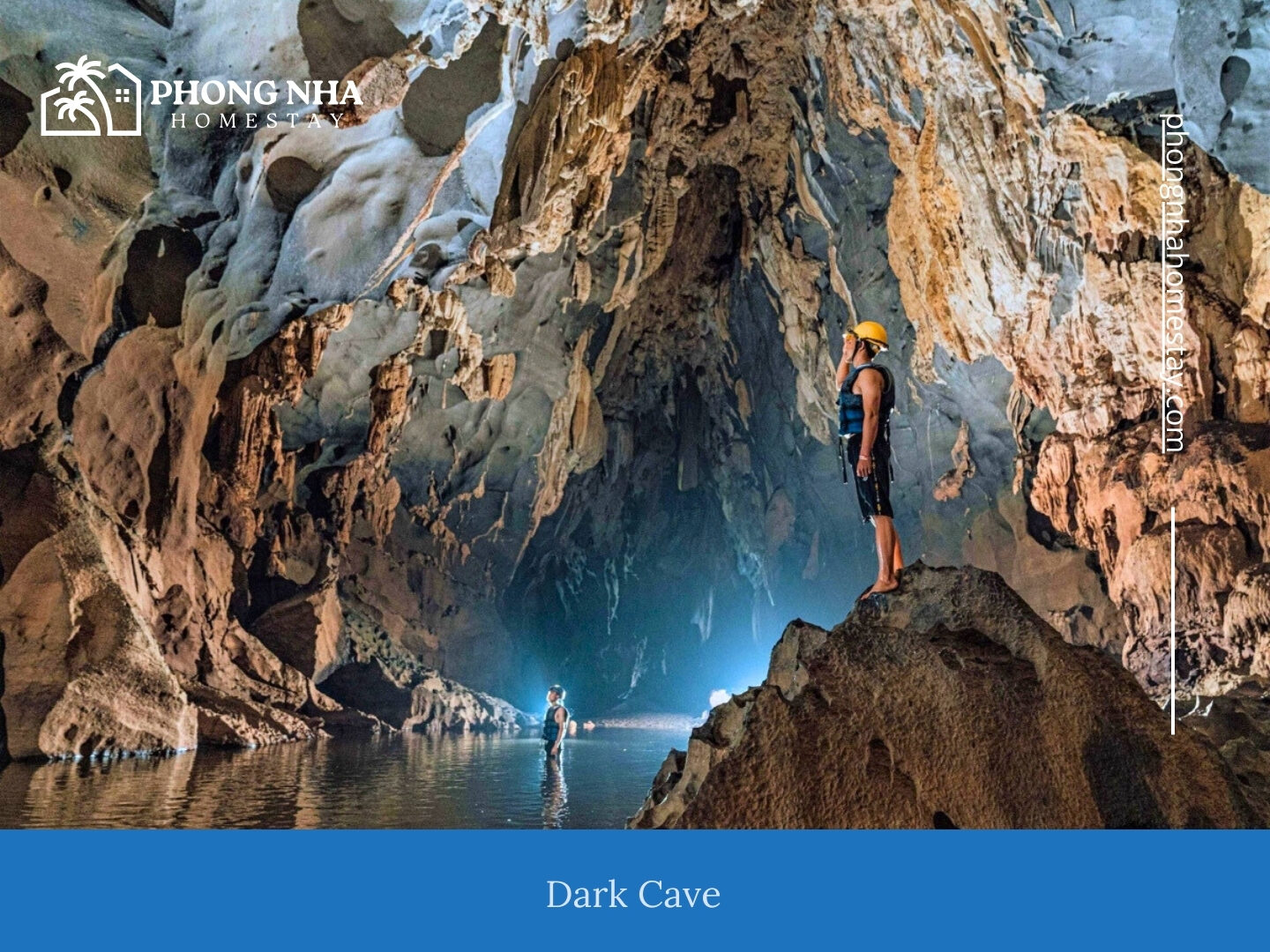
3.2 Outdoor Adventures (Hiking, Kayaking, Ziplining)
The dry season is perfect for outdoor adventures in Phong Nha. Enjoy hiking trails through the Phong Nha-Ke Bang National Park, kayaking on the Chay River, or ziplining into the Dark Cave. The pleasant weather ensures safety and maximum enjoyment.
- Hiking: Trails range from beginner-friendly routes in the Botanic Garden to challenging treks through jungle terrains.
- Kayaking: Paddle along the serene rivers, particularly around Mooc Stream for a peaceful experience.
- Ziplining: Thrill-seekers will love the high-speed zipline into the Dark Cave.
Pro Tips:
- When to go: Mornings are cooler, and you’ll have more daylight for activities.
- Gear up: Wear lightweight, breathable clothing and sunscreen for long hours outdoors.
3.3 Photography and Nature Observation
For photographers and nature enthusiasts, March to April and October provide the best conditions. These shoulder months offer lush landscapes, vibrant greenery, and mild weather—ideal for capturing the beauty of Phong Nha.
Highlights include:
- Son River at dawn: Perfect for stunning sunrise shots with misty backdrops.
- Botanic Garden: A haven for birdwatchers and macro photography enthusiasts.
- Paradise Cave: Its dramatic stalactites and stalagmites make for breathtaking images.
Pro Tips:
- Golden hours: Early mornings and late afternoons provide the best lighting.
- Pack essentials: Bring a sturdy tripod, extra batteries, and a waterproof camera bag.
Accessibility During Different Seasons
4.1 Impact of Rainfall on Caves and Attractions
Phong Nha’s rainy season (September to January) brings heavy rainfall, which significantly impacts accessibility to some caves and attractions. Phong Nha Cave, for instance, often becomes inaccessible due to rising water levels in the Son River, making boat trips impossible. Meanwhile, caves like Tien Son and Paradise Cave remain accessible since they are not affected by water levels.
Rainfall also transforms the surrounding landscapes into lush greenery, offering a different kind of beauty. However, visitors should always confirm the status of caves before planning their trip during this season.
Pro Tips:
- Check weather updates and consult local guides for the latest cave access information.
- Carry rain gear and waterproof bags to protect your belongings.
4.2 Transportation Challenges in the Rainy Season
Heavy rainfall and potential flooding during the rainy season can disrupt transportation in Phong Nha and its surroundings. Roads leading to key attractions may become slippery or temporarily closed, making travel less predictable. Public buses from Dong Hoi might face delays, while taxis and shuttles can charge higher fees due to poor road conditions.
Visitors arriving by train or flight should arrange reliable transport to Phong Nha in advance and account for potential weather-induced delays.
Quick Travel Tips:
- Opt for taxis or private shuttles when public transportation is unreliable.
- Allow extra time for travel and confirm transportation schedules with service providers.
4.3 Seasonal Closure of Specific Sites
Certain sites in Phong Nha are seasonally closed during the rainy season due to safety concerns. Dark Cave activities, including ziplining and kayaking, are often suspended during heavy rains. Similarly, sections of trekking trails in Phong Nha-Ke Bang National Park may be deemed unsafe.
However, some attractions like Paradise Cave and cultural experiences remain unaffected, offering alternatives for rainy-season travelers.
Sites Status:
- Closed: Phong Nha Cave, Dark Cave (depending on conditions)
- Open: Paradise Cave, Tien Son Cave, Botanic Garden
Pro Tips:
- Always inquire about the operational status of your desired attractions upon arrival.
- Consider alternative experiences such as cultural tours or visiting nearby towns.
Tourist Considerations
5.1 Crowd Levels and Accommodation Availability
During the peak seasons (February to April and June to August), Phong Nha sees high visitor traffic, especially around major attractions like Son Doong Cave and Paradise Cave. Accommodations fill up quickly, and prices may rise due to demand. Travelers planning visits during these months should book hotels, homestays, and tours well in advance to secure their preferred options.
In contrast, the off-season (September to January) offers quieter attractions and discounted accommodations. While some sites may be closed, this is the perfect time for a peaceful getaway.
Pro Tips:
- For peak season: Book at least 1-2 months ahead for tours and lodging.
- For off-season: Take advantage of lower rates and explore less crowded trails.
5.2 Budget Implications by Season
Your travel costs in Phong Nha can vary significantly depending on the season. During the dry season, higher prices for accommodations and tours are common due to increased demand. In the rainy season, budget-conscious travelers can enjoy discounts on stays and activities, but may face additional costs for transport or weather-related adjustments.
Seasonal Budget Snapshot:
- Peak season (dry months): Higher rates but optimal conditions for outdoor activities.
- Off-season (rainy months): Lower prices, but some attractions may be inaccessible.
Pro Tips:
- Save money: Look for homestays offering package deals during the rainy season.
- Plan wisely: Allocate extra funds for transportation during bad weather.
5.3 Weather Preparedness and Packing Tips
Packing strategically for Phong Nha is essential to ensure a comfortable trip. For the dry season, focus on lightweight clothing, sunscreen, and comfortable footwear for long treks. During the rainy season, waterproof gear like jackets, shoes, and bags are must-haves. Always include essentials like mosquito repellent and a refillable water bottle regardless of the season.
Packing Essentials by Season:
- Dry season: Breathable clothes, sunscreen, sunglasses, and a hat.
- Rainy season: Waterproof jackets, sturdy shoes, quick-dry clothing, and rain covers for backpacks.
Pro Tips:
- Layer your clothing to adapt to temperature changes, especially during early mornings or evenings.
- Carry a small first-aid kit with essentials like bandages and antiseptic for trekking or cave exploration.
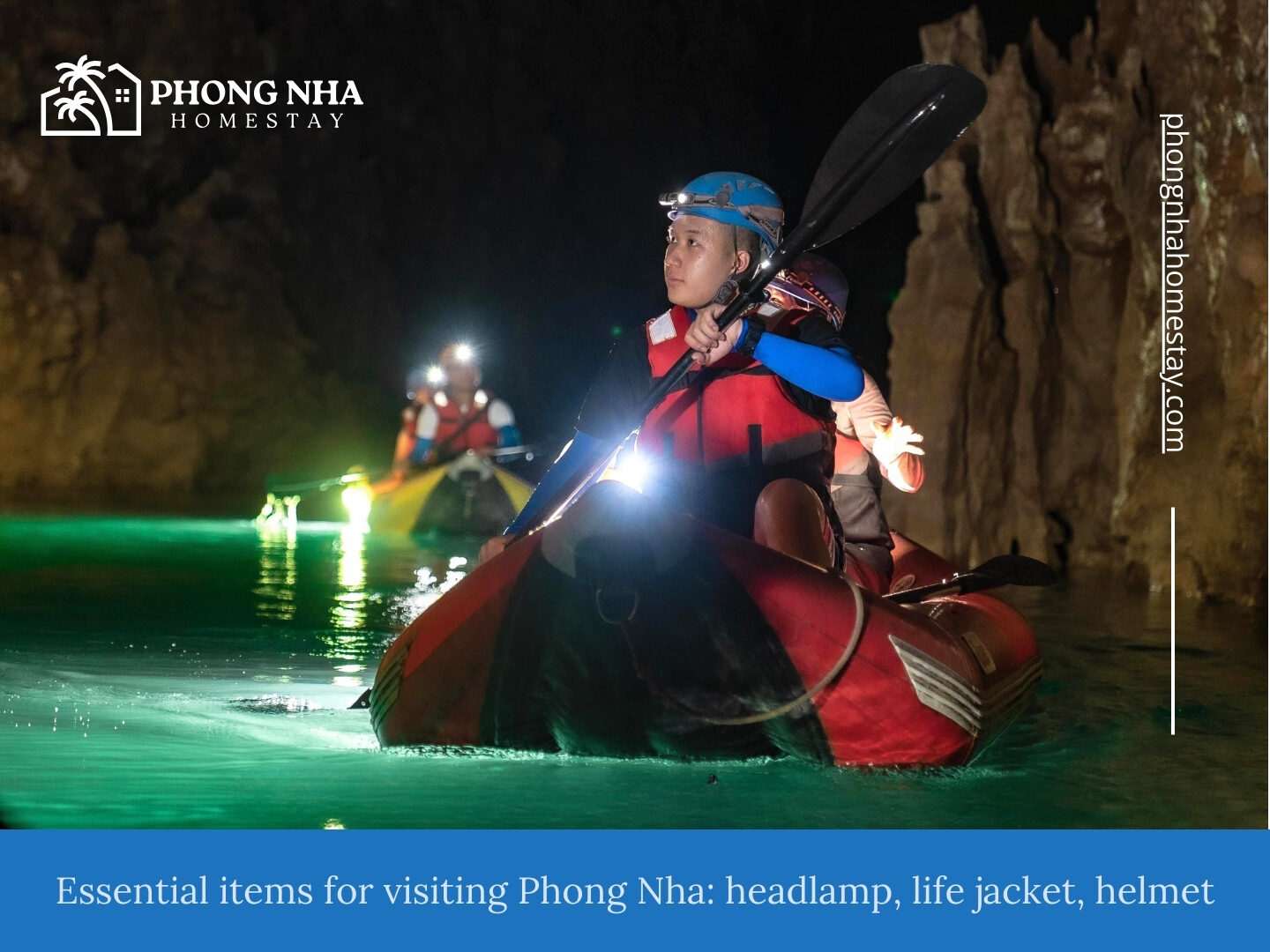
Cultural and Local Events
6.1 Key Festivals in Quang Binh Province
Quang Binh is not just about caves and landscapes; it’s also home to vibrant festivals that showcase the region’s rich culture and traditions. One standout event is the Dong Hoi Fish Worshipping Festival, held annually in early April. This festival celebrates the fishing community’s connection to the sea with rituals, performances, and boat races.
Another highlight is the Traditional Boat Racing Festival, typically occurring during the Lunar New Year. Visitors can witness thrilling races along the Son River, set against the backdrop of Phong Nha’s stunning scenery.
Festival Highlights:
- Dong Hoi Fish Worshipping Festival: April; features rituals and seafood feasts.
- Boat Racing Festival: Lunar New Year; exciting races and vibrant celebrations.
Pro Tip: Arrive early to secure a good spot to watch these events and mingle with locals for an authentic experience.
6.2 Local Community Activities and Attractions
Phong Nha’s community offers a blend of cultural charm and hands-on experiences for visitors. Engage in village tours where you can learn traditional crafts like bamboo weaving or try your hand at local farming techniques. The Phong Nha Market is another must-visit, bustling with fresh produce, handmade goods, and authentic street food.
For those interested in history, the Tam Toa Church ruins in Dong Hoi offer a glimpse into Quang Binh’s wartime past, creating a sobering yet fascinating cultural experience.
Notable Activities:
- Village tours: Learn crafts like bamboo weaving and rice farming.
- Phong Nha Market: Shop for local products and enjoy authentic street food.
- Tam Toa Church: Explore wartime history and unique architecture.
Pro Tip: Guided village tours often include meals with local families, offering a deeper connection to the community.
6.3 Seasonal Culinary Experiences
Quang Binh’s culinary scene is as diverse as its landscapes, with seasonal specialties that are a delight for food lovers. During the dry season, fresh seafood like grilled squid and steamed clams are at their peak, sourced directly from the coast. In the rainy season, hearty dishes such as bun rieu cua (crab noodle soup) provide warmth and comfort.
Don’t miss the chance to sample banh xeo Phong Nha, crispy rice pancakes stuffed with pork, shrimp, and bean sprouts, often served at roadside eateries year-round.
Culinary Highlights:
- Dry season: Grilled squid and steamed clams from Dong Hoi’s coastal markets.
- Rainy season: Bun rieu cua and warm stews for cozy dining.
- Year-round: Banh xeo Phong Nha – perfect for a quick, flavorful bite.
Pro Tip: Visit local food stalls early in the evening for the freshest flavors and to avoid crowds.
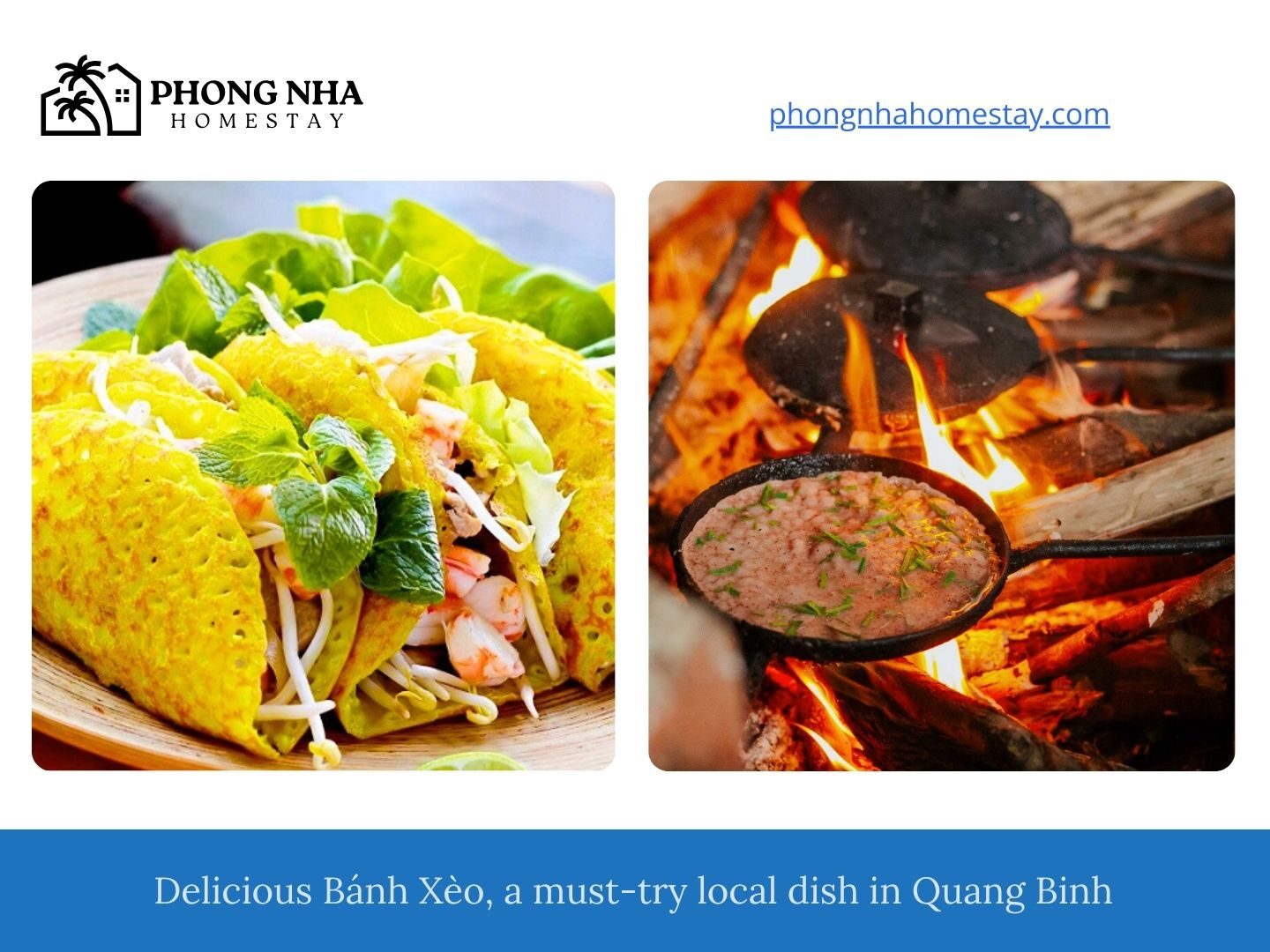
Travel Tips for Planning a Trip
7.1 Researching Weather Forecasts
Planning a trip to Phong Nha starts with checking the weather forecast, especially since the region experiences distinct dry and rainy seasons. During the dry season (February to August), expect sunny skies and comfortable conditions for outdoor activities. The rainy season (September to January) brings unpredictable weather, with frequent downpours and occasional flooding.
Use reliable weather apps or local forecasts to plan your activities effectively. For instance, confirm cave accessibility in advance during the rainy months to avoid disappointment.
Pro Tips:
- Dry season: Perfect for exploring caves and trekking.
- Rainy season: Double-check river levels and road conditions before departure.
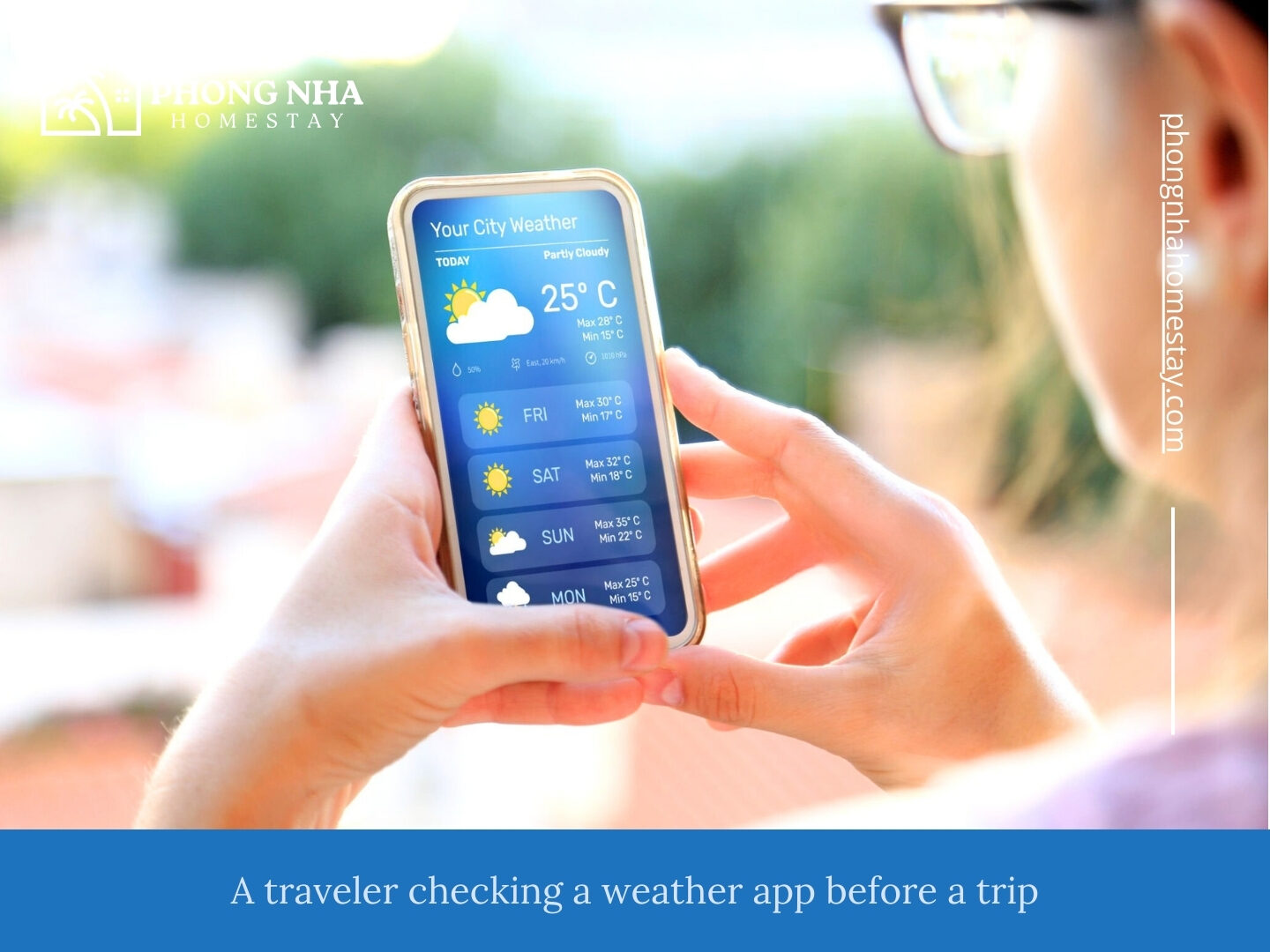
7.2 Packing Essentials for Dry and Wet Seasons
Packing smartly can make or break your trip to Phong Nha. For the dry season, lightweight clothing, sunscreen, and sunglasses are must-haves to combat the heat. On the other hand, during the rainy season, prioritize waterproof gear such as jackets, shoes, and bags to stay dry and comfortable.
Regardless of the season, carry a reusable water bottle, insect repellent, and a compact first-aid kit for outdoor activities. Sturdy, comfortable footwear is also crucial for trekking and cave exploration.
Packing Checklist:
- Dry season: Sunscreen, sunglasses, hat, and breathable clothes.
- Rainy season: Waterproof jacket, quick-dry clothes, rain cover for backpacks.
- Year-round: Sturdy shoes, reusable water bottle, insect repellent.
Pro Tip: Roll your clothes to save space and use ziplock bags to organize essentials.
7.3 Sustainable Tourism Practices
Phong Nha’s pristine beauty relies on responsible tourism, and visitors can play a part in preserving its unique ecosystems. Always carry a reusable water bottle to reduce plastic waste and stick to designated trails during treks to avoid damaging natural habitats.
Support the local community by dining at family-owned eateries and purchasing handcrafted goods from village markets. Respect local customs and avoid littering in caves and outdoor areas.
Sustainability Tips:
- Eco-friendly practices: Use refillable bottles and avoid single-use plastics.
- Community support: Choose local accommodations and businesses.
- Respect nature: Leave no trace; take only pictures and leave only footprints.
Pro Tip: Opt for guided tours that follow ethical and environmentally friendly practices.
Comparison with Other Destinations
8.1 Phong Nha vs. Other National Parks in Vietnam
Phong Nha-Ke Bang National Park stands out among Vietnam’s national parks for its unparalleled cave systems, such as Son Doong, the largest cave in the world, and Paradise Cave, renowned for its stunning formations. While destinations like Cat Tien National Park focus on wildlife conservation and trekking, or Ba Be National Park on serene lakes and rivers, Phong Nha offers an adventure-centric experience with activities like ziplining, kayaking, and jungle trekking.
Unlike the dense forests of Pu Luong or the limestone landscapes of Tam Coc, Phong Nha combines biodiversity with dramatic karst formations, making it a haven for both adventure enthusiasts and nature lovers.
Comparison Snapshot:
- Phong Nha: World-class caves, adventure tourism, jungle trekking.
- Cat Tien: Primates and birdwatching in a lush forest.
- Ba Be: Peaceful lakes, boating, and local villages.
- Pu Luong: Rice terraces, hiking, and eco-tourism.
Pro Tip: For thrill-seekers, Phong Nha’s cave expeditions and outdoor adventures are unmatched.
8.2 How Phong Nha’s Climate Differs from Other Regions
Phong Nha’s tropical monsoon climate features distinct dry and rainy seasons, similar to Vietnam’s northern and central regions. However, its location near the coast and its karst landscape make the weather unique. Unlike Sapa, which experiences cooler, alpine conditions, or Da Lat, known for its temperate “spring-like” climate year-round, Phong Nha sees hotter summers, with temperatures reaching 41°C (105°F), and milder winters, dropping to 6°C (42°F).
Rainfall is another defining factor. Phong Nha’s rainy season, from September to January, often brings heavy downpours and occasional floods, in contrast to the consistent drizzle in Hue or the drier conditions in Hoi An during the same period.
Climate Comparison Table:
| Destination | Climate Type | Dry Season | Rainy Season | Unique Feature |
|---|---|---|---|---|
| Phong Nha | Tropical Monsoon | February–August | September–January | High rainfall; dramatic caves |
| Sapa | Subtropical Highland | March–May; October | June–August | Cool, misty weather |
| Da Lat | Temperate Highland | December–March | May–October | Mild, spring-like conditions |
| Hue | Tropical Monsoon | April–August | September–November | Frequent light rain |
Pro Tip: Visit Phong Nha during the dry season for better access to caves, while other regions may be more appealing in their respective cooler months.
In conclusion, the best time to visit Phong Nha depends on your travel preferences, whether you’re seeking thrilling adventures, tranquil nature escapes, or cultural experiences. The dry season (February to August) is perfect for outdoor activities like exploring Son Doong or Paradise Cave, while the rainy season (September to January) offers lush greenery and quieter attractions. No matter when you visit, Phong Nha promises unforgettable memories with its unique landscapes and welcoming local culture. Ready to plan your trip? Visit PhongNhaHomestay.com for expert tips, accommodations, and more!
